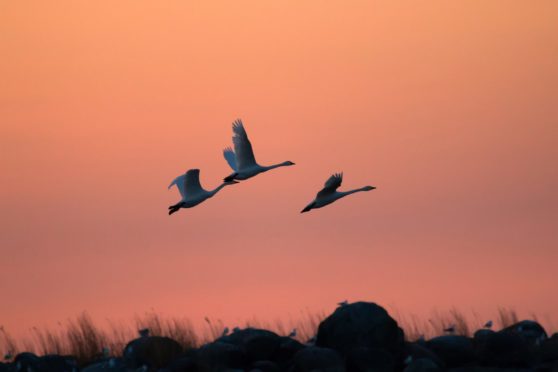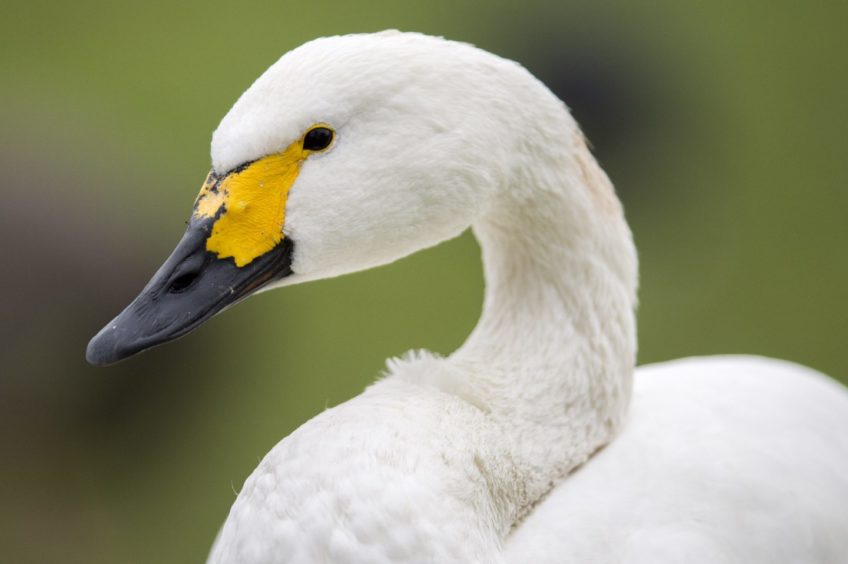
From top to toe and edge to edge, the world was the most exquisite pale grey you will ever see, and it shivered.
The morning was sunless, colourless, shadowless, shadeless, a state of landscape monochrome that can only ever be achieved by serious degrees of frost. Rootless trees floated into being from iced, misted air, advancing and receding.
There were no hills, no contours, no fields, no earth; where earth should meet sky there was only grey.
I had headed east from Stirling in a four-wheel-drive. The road to Loch Leven, where Kinross and Fife rub shoulders, is a well-worn groove on the map of Scotland I carry in my head, which was just as well on such a morning, for next to nothing was visible.
At the loch, I stepped out into a small wood of Scots pine and stood still to listen, but there was nothing at all to hear. The pines grew almost to the water’s edge, a small horde of giants. Beyond the last of them, a scrap of a sandy beach felt as brittle as beechmast underfoot.
The handful of square yards of loch between the shore and the frontier of mist were grey ice. My lasting impression of the morning was that it all looked and felt like a souvenir of a very old winter. Remember when winter used to get really cold and milk bottles stuck to the front doorstep? That kind of very cold winter.
Perhaps the whole loch was frozen? Maybe, but with so many thousands of wildfowl including hundreds of swans, the chances were they had kept at least a few acres of open water through the night.
I listened harder. There, at the edge of hearing, were geese. Pinkfeet, far off, impossible to tell if they were grounded or flying, the chorale surprisingly musical for a goose; it seemed to waver on the air, as if the thousands of notes were colliding with millions of particles of ice, a chimerical sound, as much air as substance.
Then swans called from the mist, much closer than the geese, the singularly unmusical, guttural snorts and sneezes of mute swans, but impossible to say where or how many. I was hoping for whooper swans, but then I am always hoping for whooper swans.
The loch almost always hosts something between a few and a flock from September to April, although they are restless travellers whose migrations criss-cross the country through the winter. But there was no whooper swan voice, and I could see no more than I could hear.There is a limit to how long you can stare at frozen mist, to how long you can focus on nothing. Walk the edge of the ice, soundlessly, stop often, listen – let your ears watch. Then a new note appeared, muted and mellow.
“Ooop!” it said.
It sounded both soft and close, but too soft, maybe too mellow for a whooper swan. Then a shape began to form in the mist, a slightly darker grey that slowly coalesced into a swan shape. Mist takes liberties with shapes, magnifies and distorts. As swans go, and for a few moments, this could have been anything from a mute swan cygnet to a trumpeter swan. But it didn’t sound like either. Then, “Ooop!” it said again.
Then it pushed through the frontier of the mist and stood there on the ice not 20 yards away, and it was bright white and not much bigger than a goose. Its beak was black at the front but a squared-off patch of vivid yellow tapered upwards to a vivid black eye that stared at me. It was a Bewick’s swan which, in this part of the world, is in the rarities category. It is quite possible this compact little beauty making pointed eye contact on the north shore of Loch Leven began its migration on the north shore of Siberia, and had arrived via northern Russia, Scandinavia, Denmark, and even Germany and the Netherlands before it opted to cross the North Sea.
It’s a swan with four names. “Bewick’s swan” because when it was finally recognised as a separate species in 1830 by the English zoologist and naturalist William Yarrell, he named it after the engraver Thomas Bewick whose bird art he admired. A better name is “tundra swan” because it is a circumpolar breeder and the tundra of the north of the world is where it breeds. In Canada and America it is known as the “whistling swan”. But the best name of all is the Gaelic one, “eala-bheag”. It means the wee swan, which is what it is.
Wherever it breeds along the Arctic edge, it makes huge migratory journeys south. From Siberia and Russia to East China, Korea and Japan and to Western Europe and the Fens region of England; and from the Canadian Arctic to the United States.
“Ooop!”
“Ooop!”
Suddenly there was a conversation. Then, just as eerily as the first, a second bird stepped through the mist curtain. And, one by one, with the irresistible illusion of ghosts, the shapes of three more emerged to stand beside the others. Five Bewick’s swans, straight-necked and still, dazzled even in such sunlessness, and the five tiny splashes of yellow on their beaks were the only colour in the world. It lent them a compelling intensity, so that for as long as they stood there nothing else mattered.
In 21st Century Scotland, five Bewick’s swans in a single group are a lot. Throughout the 19th and early 20th Centuries they came in abundant flocks and lingered. But something not fully understood steadily reduced the numbers so that by the mid-1950s they had virtually stopped coming. Since then, their essential wetland habitat has been trashed by farming practice, and today it is only at a handful of sites across Britain dedicated as nature reserves their presence is anything like reliable. In Scotland, that reduces to two – Caerlaverock on the Solway and Loch Leven.
I froze – metaphorically, the perfect match for the fact that I had already frozen physically – which was absolutely the only thing I could bring to the situation, unless you factor in the admiring nature of my gaze and the gratitude I felt for the moment.
It has been my experience that severe weather conditions sometimes diminish wariness in the wariest of creatures. The five swans simply stood. They looked at me. They looked at each other. They muttered sotto voce variations on the theme of “Ooop!” but the overriding impression they conveyed was that they were relaxed.
Stillness is everything at such moments. I had a camera and a sketchbook in a small backpack and in any other circumstance that had brought me even half as close to such a piece of wild theatre I would have reached for one of them. But moving was not an option. There was a spell and I was held by it. You get this close, this kind of privilege, probably only once. You fill your eyes, your ears your mind, and in the process you make it unforgettable.
Eventually, the nearest bird simply turned left and walked back into the mist. The others followed one by one, each turning to its left, walking line astern. The mist swallowed them whole.
Thinking about the moment now, its most remarkable characteristic is that nothing happened.
I learned nothing about Bewick’s swans that I didn’t know before, they imparted no secrets, they simply appeared on foot, lingered, turned and disappeared on foot. But they were ambassadors from the Arctic tundra, they had crossed a continent to stand on this, my familiar shore. It was like a greeting. Greetings from the Arctic. I wished them a safe journey in their wandering wherevers – and a thank you.
Into the Wild: jimcrumleynature.com

Enjoy the convenience of having The Sunday Post delivered as a digital ePaper straight to your smartphone, tablet or computer.
Subscribe for only £5.49 a month and enjoy all the benefits of the printed paper as a digital replica.
Subscribe © PA
© PA